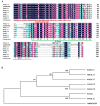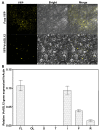Ectopic Expression of MADS-Box Transcription Factor VvAGL12 from Grape Promotes Early Flowering, Plant Growth, and Production by Regulating Cell-Wall Architecture in Arabidopsis
- PMID: 38003021
- PMCID: PMC10671436
- DOI: 10.3390/genes14112078
Ectopic Expression of MADS-Box Transcription Factor VvAGL12 from Grape Promotes Early Flowering, Plant Growth, and Production by Regulating Cell-Wall Architecture in Arabidopsis
Abstract
The MADS-box family, a substantial group of plant transcription factors, crucially regulates plant growth and development. Although the functions of AGL12-like subgroups have been elucidated in Arabidopsis, rice, and walnut, their roles in grapes remain unexplored. In this study, we isolated VvAGL12, a member of the grape MADS-box group, and investigated its impact on plant growth and biomass production. VvAGL12 was found to localize in the nucleus and exhibit expression in both vegetative and reproductive organs. We introduced VvAGL12 into Arabidopsis thaliana ecotype Columbia-0 and an agl12 mutant. The resulting phenotypes in the agl12 mutant, complementary line, and overexpressed line underscored VvAGL12's ability to promote early flowering, augment plant growth, and enhance production. This was evident from the improved fresh weight, root length, plant height, and seed production, as well as the reduced flowering time. Subsequent transcriptome analysis revealed significant alterations in the expression of genes associated with cell-wall modification and flowering in the transgenic plants. In summary, the findings highlight VvAGL12's pivotal role in the regulation of flowering timing, overall plant growth, and development. This study offers valuable insights, serving as a reference for understanding the influence of the VvAGL12 gene in other plant species and addressing yield-related challenges.
Keywords: VvAGL12; cell wall; grape; plant growth.
Conflict of interest statement
The authors declare no conflict of interest.
Figures







Similar articles
-
OsMADS22 interacts with OsMADS50 to regulate floral transition in rice.Biochem Biophys Res Commun. 2025 Apr 9;757:151607. doi: 10.1016/j.bbrc.2025.151607. Epub 2025 Mar 11. Biochem Biophys Res Commun. 2025. PMID: 40088677
-
Characterization of MADS-box genes in Chinese cherry and overexpression of CpMADS2 promoting early flowering in transgenic Arabidopsis.J Plant Physiol. 2025 Sep;312:154583. doi: 10.1016/j.jplph.2025.154583. Epub 2025 Aug 12. J Plant Physiol. 2025. PMID: 40840125
-
The MADS-box gene XAANTAL1 participates in Arabidopsis thaliana primary root growth and columella stem cell patterns in response to ROS, via direct regulation of PEROXIDASE 28 and RETINOBLASTOMA-RELATED genes.J Exp Bot. 2025 Jan 10;76(2):411-432. doi: 10.1093/jxb/erae415. J Exp Bot. 2025. PMID: 39377268 Free PMC article.
-
Signs and symptoms to determine if a patient presenting in primary care or hospital outpatient settings has COVID-19.Cochrane Database Syst Rev. 2022 May 20;5(5):CD013665. doi: 10.1002/14651858.CD013665.pub3. Cochrane Database Syst Rev. 2022. PMID: 35593186 Free PMC article.
-
Systemic pharmacological treatments for chronic plaque psoriasis: a network meta-analysis.Cochrane Database Syst Rev. 2021 Apr 19;4(4):CD011535. doi: 10.1002/14651858.CD011535.pub4. Cochrane Database Syst Rev. 2021. Update in: Cochrane Database Syst Rev. 2022 May 23;5:CD011535. doi: 10.1002/14651858.CD011535.pub5. PMID: 33871055 Free PMC article. Updated.
Cited by
-
Identification and Characterization of SQUAMOSA Promoter Binding Protein-like Transcription Factor Family Members in Zanthoxylum bungeanum and Their Expression Profiles in Response to Abiotic Stresses.Plants (Basel). 2025 Feb 8;14(4):520. doi: 10.3390/plants14040520. Plants (Basel). 2025. PMID: 40006777 Free PMC article.
-
The lncRNA LOC100257036 and vvimiR156 modulate gibberellin signaling through AGAMOUS during cluster formation in Sistan Yaghooti grape.Sci Rep. 2025 Aug 13;15(1):29687. doi: 10.1038/s41598-025-14984-z. Sci Rep. 2025. PMID: 40804354 Free PMC article.
References
-
- Hugouvieux V., Silva C.S., Jourdain A., Stigliani A., Charras Q., Conn V., Conn S.J., Carles C.C., Parcy F., Zubieta C. Tetramerization of MADS family transcription factors SEPALLATA3 and AGAMOUS is required for floral meristem determinacy in Arabidopsis. Nucleic Acids Res. 2018;46:4966–4977. doi: 10.1093/nar/gky205. - DOI - PMC - PubMed
Publication types
MeSH terms
Substances
Grants and funding
LinkOut - more resources
Full Text Sources

